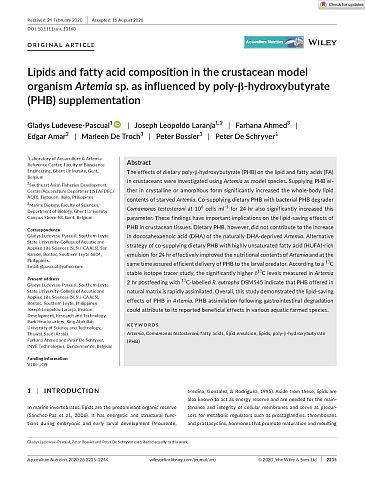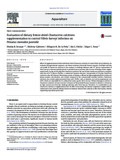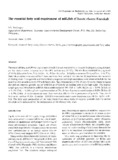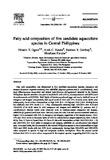Lipids and fatty acid composition in the crustacean model organism Artemia sp. as influenced by poly‐β‐hydroxybutyrate (PHB) supplementation
Share
Abstract
The effects of dietary poly-β-hydroxybutyrate (PHB) on the lipid and fatty acids (FA) in crustaceans were investigated using Artemia as model species. Supplying PHB either in crystalline or amorphous form significantly increased the whole-body lipid contents of starved Artemia. Co-supplying dietary PHB with bacterial PHB degrader Comamonas testosteroni at 106 cells ml−1 for 24 hr also significantly increased this parameter. These findings have important implications on the lipid-saving effects of PHB in crustacean tissues. Dietary PHB, however, did not contribute to the increase in docosahexaenoic acid (DHA) of the naturally DHA-deprived Artemia. Alternative strategy of co-supplying dietary PHB with highly unsaturated fatty acid (HUFA)-rich emulsion for 24 hr effectively improved the nutritional contents of Artemia and at the same time assured efficient delivery of PHB to the larval predator. According to a 13C stable isotope tracer study, the significantly higher δ13C levels measured in Artemia 2 hr postfeeding with 13C-labelled R. eutropha DSM545 indicate that PHB offered in natural matrix is rapidly assimilated. Overall, this study demonstrated the lipid-saving effects of PHB in Artemia. PHB assimilation following gastrointestinal degradation could attribute to its reported beneficial effects in various aquatic farmed species.
Suggested Citation
Ludevese-Pascual, G., Laranja, J. L., Ahmed, F., Amar, E., De Troch, M., Bossier, P., & De Schryver, P. (2020). Lipids and fatty acid composition in the crustacean model organism Artemia sp. as influenced by poly‐β‐hydroxybutyrate (PHB) supplementation. Aquaculture Nutrition , 26(6), 2235-2244. https://doi.org/10.1111/anu.13160
Subject
Taxonomic term
Collections
- AQD Journal Articles [1248]
Related items
Showing items related by title, author, creator and subject.
-
Evaluation of dietary freeze-dried Chaetoceros calcitrans supplementation to control Vibrio harveyi infection on Penaeus monodon juvenile
Seraspe, Ebonia B.; Gabotero, Shirleny; de la Peña, Milagros R.; Pahila, Ida G.; Amar, Edgar (Elsevier, 2014)Effects of supplementation of diets with freeze-dried Chaetoceros calcitrans to control Vibrio harveyi infection are evaluated through immune responses, and disease resistance of juvenile Penaeus monodon. Total lipid and ... -
The essential fatty acid requirement of milkfish (Chanos chanos Forsskal)
Borlongan, Ilda G. (Springer Verlag, 1992)The essential fatty acid (EFA) requirement of milkfish was examined by a 12-week feeding trial using defined, purified diets at water temperature of 28–29°C and salinity of 32‰. The test diets contained varying levels of ... -
Fatty acid composition of five candidate aquaculture species in Central Philippines
Ogata, Hiroshi Y.; Emata, Arnil C.; Garibay, Esteban S.; Furuita, Hirofumi (Elsevier, 2004)Fatty acid composition was determined in five candidate aquaculture species, mangrove red snapper (Lutjanus argentimaculatus), two rabbitfish (Siganus guttatus and S. canaliculatus), coral trout (Plectropomus leopardus) ...




